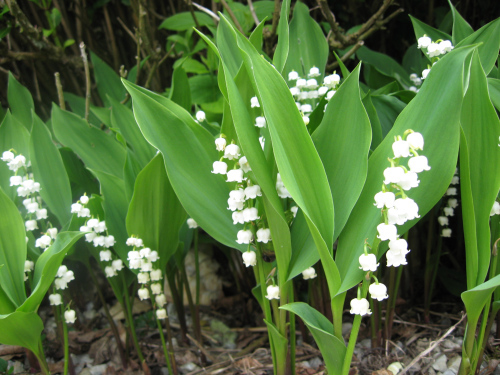May Day / La Fête du Muguet in France is a public holiday / a jour fériés to celebrate workers rights! in the UK we move it to the Monday but as with most jour fériés in France they stay on the day the occur. It is also an occasion to present Muguet / Lily of the Valley or dog rose flowers to loved ones, friends and neighbours. The day is also known as La Fête du Travail which never seems to happen in the Cle France Office!
So what do people do?
People in many areas give bouquets of Muguet / Lily of the Valley or dog rose flowers, I knew a friend who would cycle around the village and surrounding villages, in a rural corner of Mayenne, giving out single stem of Muguet to all her friends and take all day doing it!
The custom is particularly common in the area around Paris known as Ile-de-France. Families with children in the rural areas get up very early in the morning and go into the woods to pick Muguet. Individuals and flower stalls in urban areas sell bouquets of Muguet / Lily of the Valley on May 1st if you don't want to go and pick some yourself. There are special regulations that allow people and some companies to sell these flowers on May 1st without paying tax or complying with retail regulations, kerching!

In industrial towns some trade unions use the day to campaign for workers rights. Some people or even large organisations also use the day to campaign for human rights in general or to demonstrate against racism or highlight current social issues.
Jour fériés:
May 1st is a public holiday. Post offices, banks, stores and other businesses are closed, Cle France remains open in the UK. Outside of tourist areas, restaurants and cafes may be closed. However, some stores in Paris, and other major towns and cities will be open. Public transport service schedules vary depending on where you live and where you want to go to. Parades and demonstrations may cause disruption to traffic in the center of large cities, particularly Paris, Reims, Rennes and Rouen.
Now for the History Lesson:
King Charles IX of France was presented with Muguet / Lily of the Valley flowers on May 1st 1561. He liked the gift and decided to present Muguet / Lily of the Valley flowers to the ladies of his court each year on May 1st. Around 1900, men started to present a bouquet of flowers to women to express their affection. The flowers are a more general token of appreciation between close friends and family members these days and has not bee turned into a second Valentines day.
The eight-hour working day was officially introduced in France on April 23, 1919, and May 1st became a public holiday. May Day was not observed during World War II. However, May 1st became a public holiday again in 1947 and officially became known as La Fête du Travail (Labor Day) on April 29, 1948. Since then, it has been an occasion to campaign for and celebrate workers' rights.
We know it as just goof old fashioned May Day but, of course, it is also known as Labor Day in other parts of the world.
Symbols:
Muguet / Lily of the Valley and dog rose flowers are symbols of May Day in France.
The Romance:
Ever since its introduction from Japan to Europe in the Middle Ages (bet you did not know that!) Muguet / Lily of the Valley has been regarded as a lucky charm by the Celtic folks from many countries.
There was also an old European tradition of 'bals de muguet' or Muguet dances; once a year, this was a rare occasion for young singles to meet without having to get parents’ permission. The girls would dress in white and the boys would wear a sprig of muguet as a buttonhole, how very quaint.
From around 1900, it became traditional in France for men to present a bouquet of flowers to their sweethearts to express their love and affection. Nowadays, sadly of course, the romance has drifted out of the tradition and 'Muguet ' flowers are really only given as a general token of appreciation between close friends and family members.
Blog submitted by: Sharon at The French Property Network - Cle France.